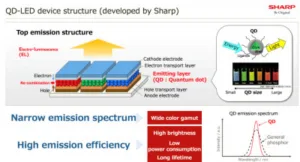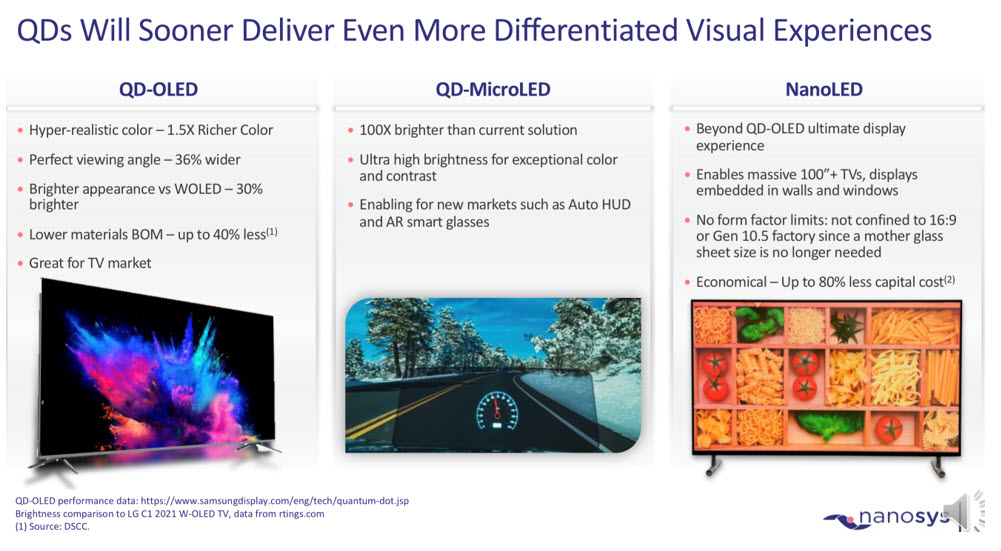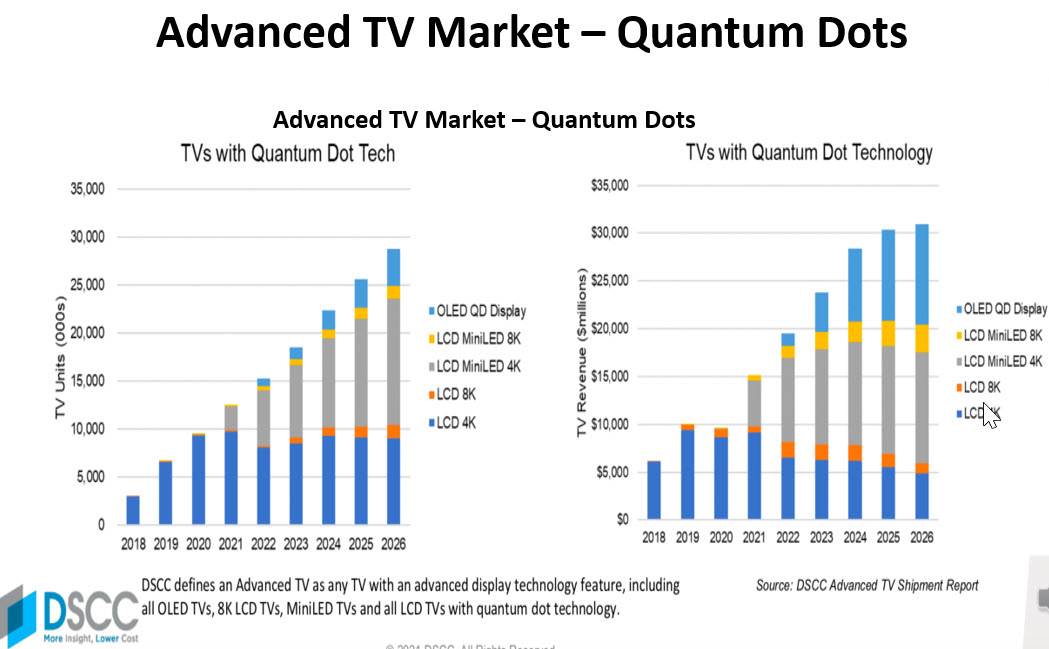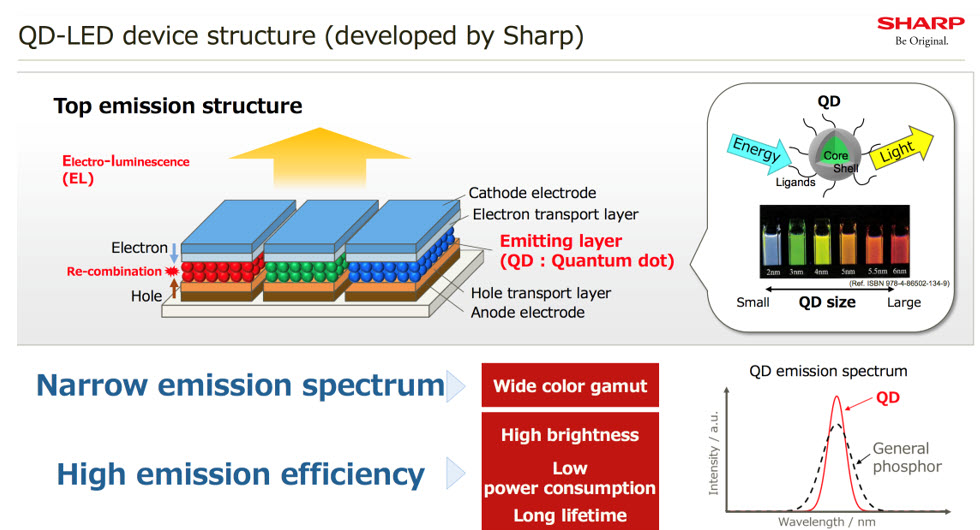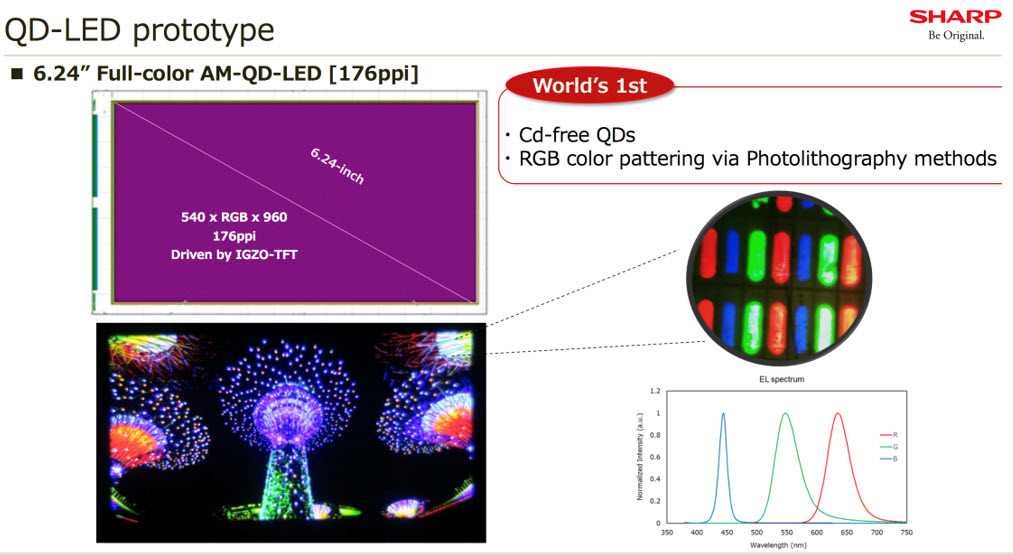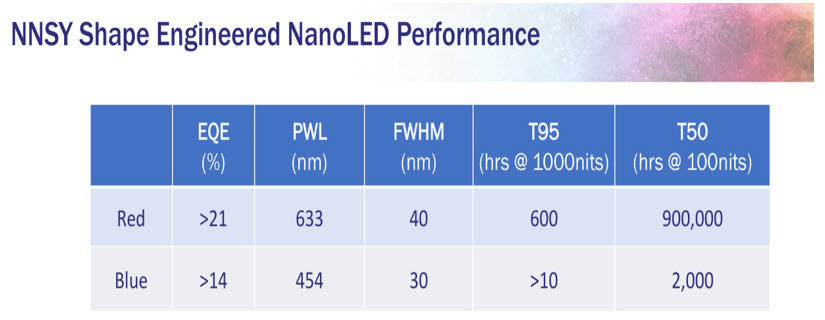Quantum Dot display technology is continuously evolving with new materials, new processes and new devices while progressing towards becoming the ultimate next generation self emissive display solution. The recent virtual “Phosphors and Quantum Dots Industry Forum” from September 14-15 gave a glimpse of the future of this display technology.

Reinventing the Display Industry
Quantum Dot Display has established itself as a formidable force with lower prices, higher product availability and improved performance enabling strong growth in shipments.
The first generation QD enhancement film (QDEF) enabled LCDs to have better color purity, wider color gamut, and offer a brighter and more immersive HDR experience while maintaining power efficiency for TV applications. The technology has evolved during the last few years to improve or eliminate many challenges resulting in broader adoption of the technology. It has enabled LCD technology to reinvent itself and has created growth opportunities. This technology is expected to enter an expansion phase in next few years through technology developments that will enhance other display architectures such as OLED and MicroLED. Finally, it aspires to be a leader by offering the most cost effective, flexible emissive Quantum Dot displays in future.
According to Jason Hartlove CEO of Nanosys in his keynote presentation: Quantum Dots: Reinventing the display Industry.
“It has already changed the industry with QDEF. QDs will sooner deliver even more differentiated visual experience with QD-OLED, QD-MicroLED and QD-nanoLED”.
Enabling OLED & MicroLED
According to Hartlove’s presentation, Next-Gen Quantum Dot Colour Conversion (QDCC) will overcome OLED limitations in 2021.
“The future of OLED plus MicroLED success requires Quantum Dot color conversion. QD pairs seamlessly with OLED. It replaces inefficient, wasteful color filters and white subpixel and simplifies the manufacturing process”.
QDOLED could combine the best of OLED and quantum dot technology: it should provide very high contrast (due to the OLED sub-pixel), perfect black, wider viewing angles with better color gamut and higher brightness. It uses solution-printed QDs as the emitter material to make AM QLED displays. Printable, low cost QD materials with superior performance have the potential to directly compete with OLED displays even in the flexible segment. However there are still many challenges. Blue emitting materials still have efficiency and lifetime issues. Multiple layers of blue OLED can be used to reduce the problem. Nanosys CEO Jason Hartlove said that he expect QDOLED to be available in 2021/22, QD MicroLED in 2023/24 and NanoLED in 2025/26. QD-OLED displays from Samsung Display are expected by the end of 2021 or early 2022.
The mass transfer process that requires bonding RGB (Red Green Blue) MicroLED to the display backplane accurately and efficiently is very challenging. Also different colors of LED need slightly different voltage and drive currents. Color conversion by Quantum Dots (QDs) (QDCC) or by phosphor provides another alternative. Using single-color (blue) MicroLED chips and color converting them with QD layers can help in the manufacturing process. According to Hartlove, QD MicroLED enables new markets such as Auto HUDs and AR smart glasses. There have been many announcements and prototypes but no mass production yet. Many things need to be resolved before commercialization of the product. MicroLED display needs a mature supply chain for high volume production. Nanosys has acquired the microLED company “gl?” to improve the supply chain and accelerate product development and adoption.
Expanding Towards the Mainstream
Nanosys recently announced the aerobically stable xQDEF concept where no barriers are required and is expected to lower costs and increase manufacturability. The “air stable” QDs material from Nanosys (no extra protection required for oxygen or moisture) and innovative co-extrusion manufacturing technology by CYD has resulted in the xQDEF diffuser plate. The barrier film has kept the cost at a higher level and restricted the supply chain to only those with barrier film capabilities in the past. New products in films or diffuser plates will open up the supply chain with a greater possibility of lower costs. The diffuser plate can be added to any simple full array local dimming backlight type TV enabling lower cost mainstream product at <$500 with QD. This technology has been embraced by brand such as TCL, Hisense. It is already in mass production.
According to DSCC presentation by cofounder Bob O’ Brien,
“DSCC expects growth in TV using QD technology to grow to 18% from 2020 to 2026. QD will be the dominant configuration on MiniLED TVs. Samsung’s QD OLED will extend the technology further.”
Evolving to Next Generation Emissive Display: Sharp Display Technology
According to Dr. Yang Qu’s presentation, next generation self-emissive displays based on QD LED combine the advantages of both LCD and OLED and is a game changer in the display industry (TV, mobile, auto etc) with its exquisite image quality, high device reliability, low cost manufacturability (existing LCD fabrication EQ available). Sharp has developed an Electroluminescence (EL) top emission structure. It has narrow emission spectrum combined with high emission efficiency that enables wide color gamut, high brightness, low power consumption and long lifetime. It has higher contrast compared to LCD and higher brightness compared to OLED and flexibility like OLED with the potential for lower cost. Samsung and Sharp have announced their plan to focus on Cd-free QDs. BOE and TCL have shown Cd-based demos. The ultimate goal of the industry is Cd-free QD emissive displays. As Sharp presented there are three major challenges for realizing QD-LED:
- Material: Cd-free QD+ narrow FWHM emission (Sharp is developing it)
- Process: RGB color Patterning (contact printing, Inkjet printing and photolithography).
- Optical Design: highly efficient light extracting structure
There are several QD patterning methods currently being considered.
- Contact printing: high resolution, low material waste, low productivity,
- Inkjet printing: high productivity, low material waste, low resolution
- Photolithography: high resolution low manufacturing cost but a disadvantage is that QD requires high process resistance.
Sharp is developing RGB color patterning QD LED via a photolithography process from LCD fabrication. Photolithography enables them to enlarge the emissive area (wider aperture, lower current density), which results in higher brightness, higher resolutions and longer lifetime. Also it enables the firm to divert existing LCD manufacturing equipment, which results in low cost production and easy to produce large size panels (OLED costs are higher due to the vacuum evaporation process). For optical design, you need highly efficient light extraction. Sharp is developing a new structure to satisfy both free viewing angle and high brightness by using QDLED narrow emission spectrum materials (using a reflective bank structure).
Samsung Advance Institute of Technology (SAIT)
Dr. Yu-Ho Won of SAIT presented on highly efficient and stable Cd-free QD LEDs and the recent research progress in InP-based Red QD-LEDs and ZnTeSe-based Blue QD-LEDs
- QD superior optical properties for display applications enable high color gamut, high brightness, wide viewing angle and high contrast. RGB EL backlight and color filter free, charge transport layer.
- The challenges for the QD LED application: High quality QDs, Shell Engineering, Ligand engineering and device structure
- Shell engineering: Improvement of EQE, brightness and lifetime in QD with thick ZnSe shell.
- Ligand Engineering: Improvement of EQE and lifetime of QD-LEDs (best performance of InP QD-LEDs)
- Recent progress in InP and ZnSeTe: They have achieved excellent red and Blue QD LED by high quality QD and shell and ligand engineering. They have improved the performance of Blue QD ZnSeTe LEDs to achieve 20% EQE, 80,000 cdm² brightness, T50 15850h @100 nits for double layer EML.
TCL is focusing on Ink Jet Printed (IJP)-QLED display development and bringing it to commercialization according to Dr. Wenyong Liu’s presentation. TCL has demonstrated an IJP-QLED emissive device with a different structure (not Cd-free) in 5-inch and 31-inch sizes. High performance QLED device mass production at low cost is feasible. For that, QD cd-free materials (especially blue) and charge transports materials need to be developed. For inkjet printing IJP fabrication process flow, film quality evaluation, and inks and inkjet printing technology are very important.
A Nanosys presentation by Ray Ma, Senior Director indicated that controlled QD synthesis with shape engineering has resulted in a significant improvement un heavy metal free NanoLEDs. Performance is reaching the commercialization level. It has the potential to address all display application with low costs.
Quantum Dot display technology is continuing its journey along the path of innovation for next generation products. To make the future potential a reality, developments need to continue in terms of materials, printing, encapsulation processes, equipment and the supply chain. (SD)
Sweta Dash is the founding president of Dash-Insights, a market research and consulting company specializing in the display industry. For more information, contact [email protected] or visit www.dash-insights.com

